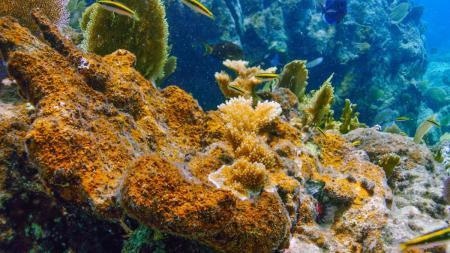Dec 1 2020
All over the world, coral health has been threatened by human activity. A new algal danger is leveraging coral’s already perilous condition in the Caribbean and rendering it more difficult for reef ecosystems to thrive.
 Peyssonnelid algal crusts spreading over a dead skeleton of Acropora palmata in shallow water in Great Lameshur Bay in St. John, U.S. Virgin Islands. Image Credit: Peter Edmunds.
Peyssonnelid algal crusts spreading over a dead skeleton of Acropora palmata in shallow water in Great Lameshur Bay in St. John, U.S. Virgin Islands. Image Credit: Peter Edmunds.
A study recently published in Scientific Reports describes how a hostile, golden-brown, crust-like alga is quickly overgrowing shallow reefs, taking the place of coral that was broken by severe storms and worsening the damage caused by bleaching, pollution, disease, and ocean acidification.
In the last four years, Bryan Wilson from the University of Oxford, Chen-Ming Fan from Carnegie Science, and Peter Edmunds from California State University Northridge have been exploring the biology and ecology of peyssonnelid algal crusts, or PAC, in the U.S. Virgin Islands, which are out-competing coral larvae for restricted surface space and further growing over the present reef architecture, highly damaging such delicate ecosystems.
This alga seems to be something of an ecological winner in our changing world.
Bryan Wilson, Study Lead Author, University of Oxford
Wilson stated that several other threats to coral communities make them more vulnerable to the algal crusts.
Initially, Edmunds noted the invasive growth of the crusts following category 5 hurricanes Irma and Maria when they were quickly taking over spaces that had been blasted clean by the storms.
Corals are marine invertebrates that develop huge exoskeletons from which reefs are built. For new reef structures to be grown, it is essential for free-floating baby corals to first successfully attach to a steady surface. They choose to settle on the crusty surface made by a particular type of friendly algae that grows on the local rocks.
Such coralline crustose algae (CCA) serve as guideposts for the coral larvae, generating biochemical signals together with their related microbial community, which induce the baby coral to attach itself.
The team was confused by the fact that both the destructive PAC and the useful CCA grow on rocks and make a crust, but PAC eliminate coral settlement and CCA induces it. What causes this variation?
The researchers set out to find how the golden-brown PAC impacts Caribbean coral reefs. They identified that the PAC fosters a microbial community that differs from the one connected with CCA, which is known to attract corals.
These PAC crusts have biochemical and structural defenses that they deploy to deter grazing from fish and other marine creatures. It is possible that these same mechanisms, which make them successful at invading the marine bio-space, also deter corals.
Chen-Ming Fan, Carnegie Science
Further studies are required to comprehend the huge success of the algal crusts in taking over Caribbean reef communities and to search for methods to reduce the threat that they pose.
“There is a new genomic and evolutionary frontier to explore to help us understand the complexity of organismal interactions on the reef, both mutualistic and antagonistic,” added Fan.
The coral and their ecosystem are so fragile as it is. They are under assault by environmental pollution and global warming. We have made their lives so fragile, yet they are sticking in there. And now this gets thrown into the mix. We don’t know if this is the straw that breaks the camel’s back, but we need to find out.
Peter Edmunds, California State University Northridge
This study was financially supported by a Long Term Research in Environmental Biology grant and a Rapid Response Research grant from the U.S. National Science Foundation.
The study was completed under permits offered by the Virgin Islands National Park.
Journal Reference:
Wilson, B., et al. (2020) An unusual microbiome characterises a spatially-aggressive crustose alga rapidly overgrowing shallow Caribbean reefs. Scientific Reports. doi.org/10.1038/s41598-020-76204-0.